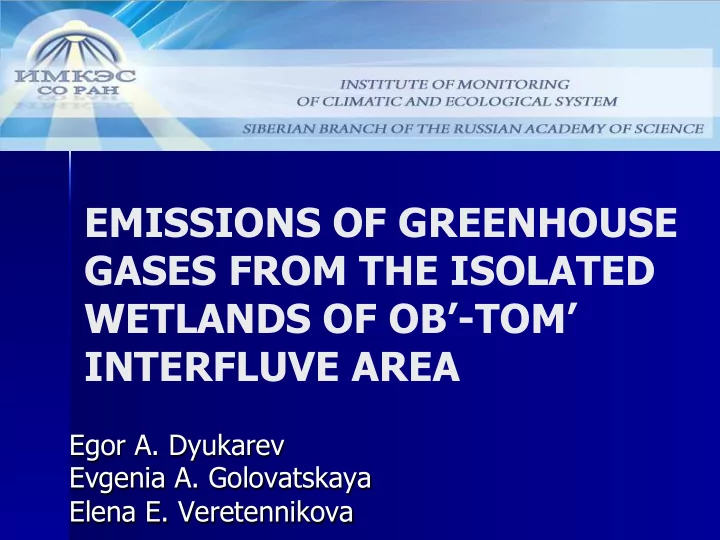

EMISSIONS OF GREENHOUSE GASES FROM THE ISOLATED WETLANDS OF OB’-TOM’ INTERFLUVE AREA Egor A. Dyukarev Evgenia A. Golovatskaya Elena E. Veretennikova
Isolated wetlands n An isolated wetland does not have a formal definition, but rather it is been defined by what it lacks. According the to US EPA's June 2007 Guidance, an isolated wetland does not have a significant nexus to a navigable waterway, or in everyday terms, no readily identifiable surface connection to a larger body of water.
Isolated wetland size n Small sized wetlands are difficult to delineate at satellite images. n Small wetlands are more vulnerable to external influence (climate change, water table lowering, pollution, anthropogenic impact) than big stable peatlands with huge water and carbon storages.
Tomsk 83 x 52 km
Landscape structure 1 – ancient river valley; 2 – denudation- accumulation plain; 3 – fluvial terrace, 4 – floodplain. Water wells line Depression in aquifer 177 water wells 250 000 m 3 water daily A. G. Dyukarev, N. N. Pologova State of Natural Environment in the Tomsk Water Intake Area // Contemporary Problems of Ecology, 2011, Vol. 4, No. 1
595 wetlands Total area – 25 636 ha 6,63 % 567 - isolated wetlands Total area – 9 714 ha 2,51 %
Isolated wetland size distribution 140 22% 22% N = 567; 120 Mean = 17,1; StdDv = 55, 2 ; Max = 769, 6 ; Min = 0,05 ha 100 50% 16% 16% S < 6,4 ha 80 No of obs 10% 10% 60 10% 10% 9% 9% 40 5% 5% 5% 5% 4%4% 4%4% 20 2%2%2%2% 2%2%2%2% 2% 2% 2% 2% 1% 1% 1%1%1%1%0%0%1%0%1% 1%1%1%1%0%0%1%0%1% 0 0 4 8 12 16 20 24 28 32 36 40 44 48 Wetland area, ha
Isolated wetland classification Bog Fen Dry
n Site 1 – “Timiryazevskoe” wetland n Site 2 – “Kirsanovskoe” 3 1 wetland 2 n Site 3 – Dry peatland
Site 1 Site 2 2a Bog 2b Fen 1b Dry 1a n 1a – pine-shrub-sphagnum n 2a – pine-shrub-sphagnum community – oligotrophic bog. community – oligotrophic bog. 420 cm, C 14 age – 5880 yr. 310 cm, C 14 age – 5300 yr n 1b – open sedge-sphagnum n 2b – open sedge-sphagnum fen. 320 cm, C 14 age – 4000 yr fen. 100 cm, C 14 age – 3050 yr
Site 1 Site 2 n 1a – pine-shrub-sphagnum n 2a – pine-shrub-sphagnum community – oligotrophic bog community – oligotrophic bog n 1b – open sedge-sphagnum fen n 2b – open sedge-sphagnum fen
Site 3 n Dry peatland Peatland with low level of bog waters and compacted peat. Surface vegetation transformed. Fire dangerous area.
CO 2 and CH 4 emission measurement n Static dark chamber method n dt = 30 min n Twice per month n May – October n 2008 – 2012
Carbon dioxide and methane emission n Fluxes of the CO 2 emission from CO 2 the surface of peat deposits were measured by the traditional dark chamber method with an infra-red gas analyzer OPTOGAZ-500.4. The opaque chamber was placed on the moss surface. CH 4 n Air sampled from the chamber was analyzed by SHIMADZU GC-14b gas chromatograph at flame- ionization detector. Methane emission was calculated from concentration rise within the chamber.
Seasonal variations of CO 2 emission Reconstruction from air temperature dependence F = a exp (b T) Q10 Dry = 1.69 Fen =1.70 Bog = 1.79
Total C emission from small isolated wetlands under antropogenic impact is 50 -80% higher than from big natural wetlands.
Total annual C emission from isolated wetlands of the study area Wetland area x CO2 + CH4 flux = Total C flux X = F Tot F Tot = 2,91 10 4 ton of C/yr
ISTC project #4079 Identification, Characterization, and Functional Assessments of Isolated Wetlands of the Former Soviet Union n Institute of Monitoring of Climatic and Ecological Systems SB RAS, Tomsk n Institute of Chemical Biology and Fundamental Medicine SB RAS, Novosibirsk n Sukachev’ Institute of Forest SB RAS, Krasnoyarsk n US Environmental Protection Agency, Cincinnati, USA
Спасибо за внимание !
Recommend
More recommend